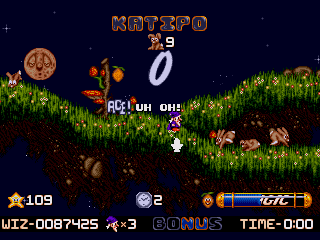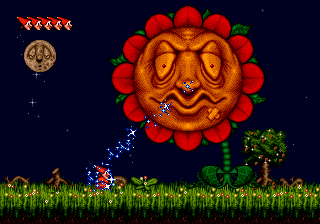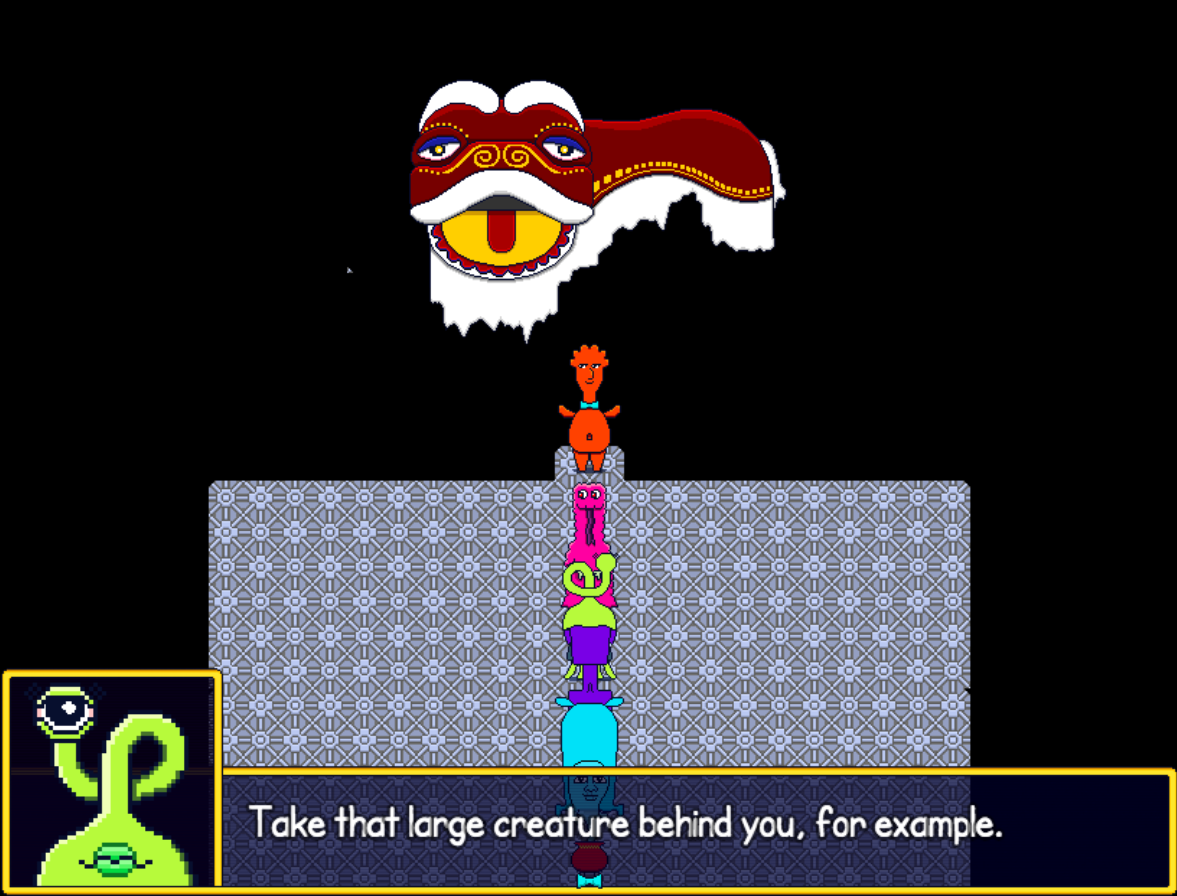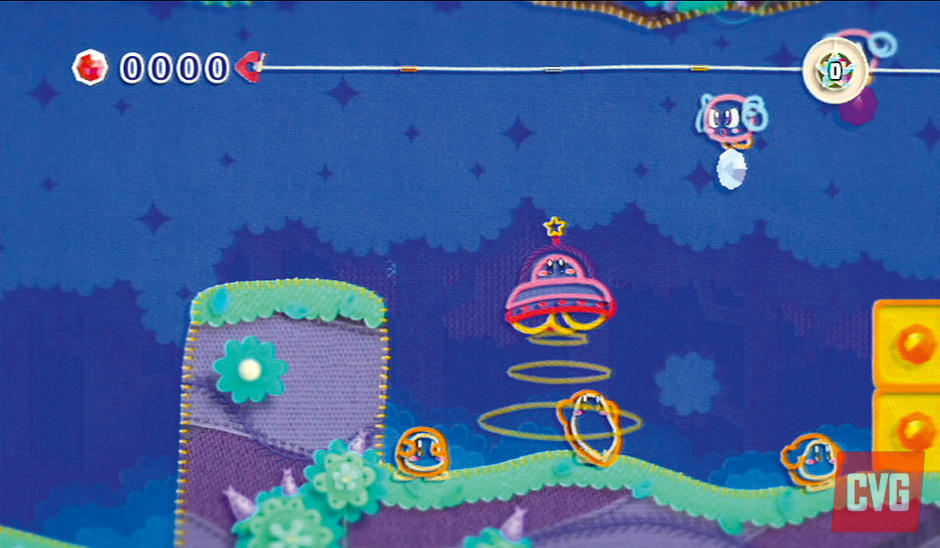This is part two of a series of posts about games that inspired Monster Garden. The first, here, was about “monster love.” For more posts on others games, visit my blog Game Make World.
Wiz ‘n’ Liz
Worldview: A magical world of whimsy
Theme: Rushing and resting
Frantic, chaotic gameplay can be one of the greatest sources of silliness. Just imagine playing Super Mario Bros Wii U with friends – things are flying around, you don’t know what’s happening or why you just died, but you can’t stop laughing.
Wiz ‘n’ Liz, released for the Sega Genesis in 1993, alternates periods of this kind of high-stakes frenzy with those of relaxed experimentation, in the process creating an off-the-wall world of whimsy and surprise.
GOALS & RULES
In each level the player saves “wabbits” and collects letters that float up from saved wabbits to spell a magic word and open an exit from the level before time runs out.

“Wood Land,” with pumpkins afloat and ready to be collected.
Unlike the typical platformer, levels don’t have enemies, pits to fall in, or even a physical end – they loop left-to-right with the player literally running in circles.
There’s always something to gather until the very last second, whether its fruits for spells, timers to gain more time for the next level, or stars that can be used to buy fruit.
Since timers and stars appear only after you’ve gathered enough fruit to take one home – ie. when you’re likely very low on time – they feel like rare and special treasures.
And, whenever you’re down to the last ten seconds there’s a chance you’ll find a glowing circle worth an extra 30 seconds – huge in Wiz n Liz time. This sets the stage for epic wins, such as the time I died when the clock hit zero, but as my character evaporated into nothingness as per the game’s death animation it came in contact with the 30 second boost and put me back in the game!

Out of time!
In between levels the player goes back to their home, where they can mix any fruits they successfully gathered to cast spells. This break times gives the player a chance to catch their breath and usually rewards them with something useful or at least fun.

The player’s home base, with the fruit-mixing cauldron on the left.
Spells’ effects include straightforward bonuses like more stars, mini-games to get extra lives, more neutral effects like randomly changing all your fruit to another type, and downright mean things like re-opening completed levels. In any case, the spells’ variety keeps the player guessing what curveball will be thrown next, and with 14 fruit it takes awhile to try all 196 combinations.

Ye Olde Magic Shoppe sells all the fruit (and time and lives).
When a certain number of rounds in each “Land” have been completed the player faces a boss.However, there’s no targeting or shooting, you simply hold down a button to continue “zapping” the boss while moving to avoid them. These boss battles are mostly a matter of following a hypnotic pattern and surviving long enough to win.

The bosses tend to have disturbingly detailed faces.
VISUALS
The visual style is what can only be described euphemistically as “90’s PC game” and may not hold up to the modern eye. But there’s no denying that the graphics are detailed and the animations smooth, especially for the era.
Naturally, a major visual focus of the game is the fruits (and vegetables, technically speaking, but the game calls them all “fruits”) used in spells. If you gather enough of the type of fruit that appears in a given level, one will float behind the player in a sparkly trail of magic, signifying that they can take it home. In addition to giving the player a sense of accomplishment, it also accentuates their movement and momentum.

A banana follows Wiz in a sparkly trail.
Afterwards the fruit appears back in home base hanging in the trees. Here it will follow behind the player just like in the levels if touched, and then can brought to the cauldron to mix a spell. The catch is that fruit only lasts for three levels, spinning faster at each stage of decay until it’s gone for good.
Being one of the only things that appears both in levels and the home base, fruit connects these two worlds of frantic frenzy and chill experimentation. It gives the player something extra to work for during levels and, if you succeed, something fun to play with during break time.


Frozen trolls and giant iguanas (???) mysteriously decorate the levels.
The fairy tale-like style of the witch and wizard couple and their cute wabbits is offset by the unexplained creepiness of secondary elements throughout the game, like the moon’s face, strange monolithic objects littered throughout levels, and the bosses’ designs. (Bosses’ faces are creepy enough to begin with, but their facial features also turn into hollow holes as you damage them, making them even more disturbing.)
This creepiness is just kinda there without any explanation, making the otherwise cute atmosphere a little unsettling.
TEXT
Comic book sound effects like “BOP!” and “ZIP!” appear whenever you rescue a wabbit, while the magic words needed to open exits are various gibberish words.
The main source of text is in the game’s commands. When arriving home after a level, for example, you’re instructed to “Mix that fruit!” while mini-games give you instructions like “Splat those dudes!” (which means launch tomatoes in the faces of two caricatures of the developers).
SOUND
“Pings,” “pows” and other audio flourishes accompany your actions, which, together with the juicy visual touches, keep things dynamic and silly.
While most of the music is upbeat and fun, boss battles use low-key tracks that suits their hypnotic nature.
CONTROLS
The only actions the player can take are running and jumping, which are used for everything from selecting levels to mixing fruit. It’s a simple but effective recipe, and whether you’re flying through a pack of wabbits or picking fruit from the trees, the controls are tight and responsive. The swerving inertia whenever you change direction also adds to the sense of urgency as you race around each level.
The mini-games unlocked with spells vary from a clone of the games “Snake” to object-collecting and obstacle-dodging games. Considering their variety it’s impressive that they all play surprisingly well.

A mini-game unlocked with a spell.
IN A NUTSHELL
The game’s frantic levels offer as much excitement as you can snatch up, while the breaks in between at your home let you relax and enjoy whatever you managed to gather. The whimsical attention to detail that permeates both sections of the game keeps it fresh and engaging despite the repetitive nature of levels.
WHAT COULD BE BETTER
Although the wide variety of spell effects helps make it feel like anything could happen, the negative ones can leave you feeling punished for experimenting. With all the imagination and care the developers put into the game, I think they could have come up with a wider variety of helpful and or at least funny spells.
INSPIRATION FOR MONSTER GARDEN
Personally, I loved collecting and combining fruit in Wiz ‘n’ Liz to see what might happen. I tried to capture this feeling in my game “Monster Garden” by having each monster character unlock different ways of interacting with the world and other characters.
Like Wiz ‘n’ Liz, Monster Garden alternates between levels (called “seedlings” in my game) that are more intimidating but also give you the chance to bring some excitement and fun back to your home base (in the form of new monster friends, in my game’s case).

The monster garden, your “home base” for the game.
Unlike Wiz n Liz, however, I wanted to provide surprise without random punishment. That’s why Monster Garden has no “game over.” Even if you fail to complete a seedling, you can always move on to the next, and you’ll never “lose” the game.
I also enjoyed the subtle creepiness throughout Wiz n Liz, especially in the boss designs. I tried to evoke this slightly off-putting atmosphere in Monster Garden, including in my own bosses.

My favorite Wiz ‘n’ Liz boss.
If you’re in the mood to explore a creepy world of whimsy and magic, then either of these games might be just what you need! There is a short demo and details about Monster Garden here on itch.io.





















